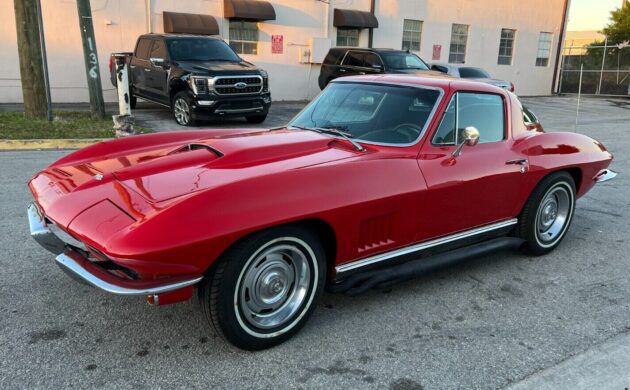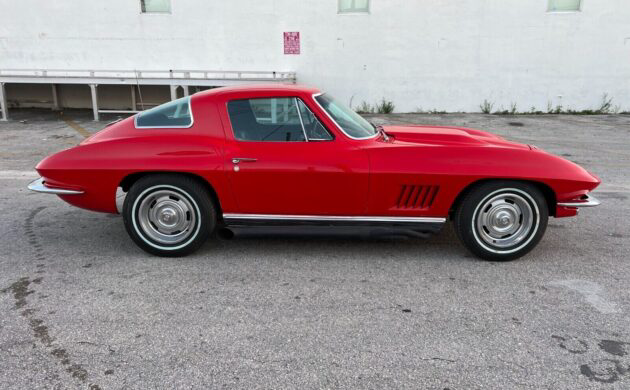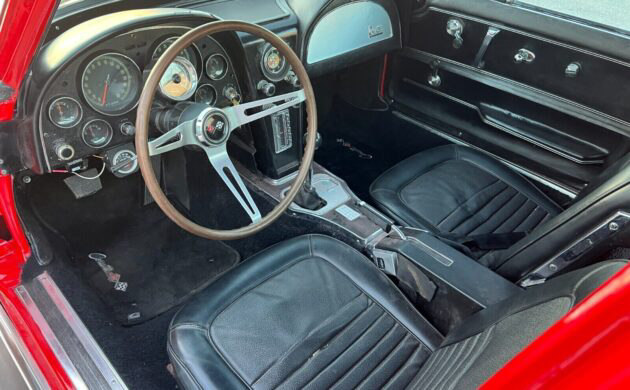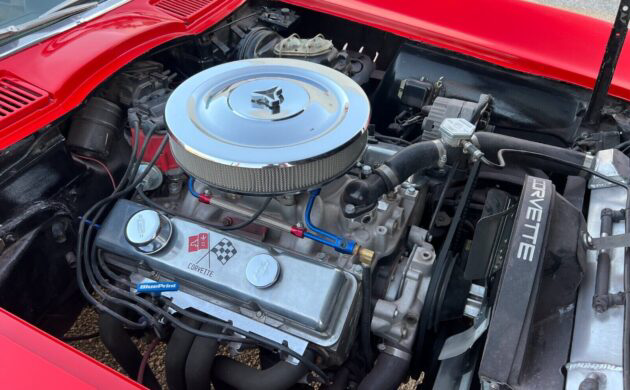Ordering a new 1967 Corvette with a big-block under the hood brought the buyer a car that demanded respect. There was never a question hanging over its potential performance, but this 1967 Corvette Coupe takes that to a higher level. It presents well as a driver-grade classic and has no immediate needs. It won’t appeal to purists, but it has attracted much attention since the seller listed it here on eBay in Miami Beach, Florida. This could be partially because of its specifications, but their decision to offer it with No Reserve is undoubtedly a contributing factor. That interest has pushed the price to $40,100, with time remaining for the action to intensify further.
The 1967 model year represented the last for production of the C2 Corvette. Its replacement was waiting in the wings, and while it wouldn’t feature many changes below the surface, its styling proved a hit. Delays in its introduction meant Chevrolet went into 1967 with a car that featured only minor changes compared to the previous year. Anticipation of the new model led some potential buyers to delay their purchase, resulting in a drop of 20% in sales volume. However, this car’s successor would take little time to make up the lost ground. Our feature ‘Vette’s presentation is acceptable for a driver-grade classic, with its most significant weaknesses confined to the interior. The Rally Red paint holds a deep shine, and although there are no visible flaws in the supplied photos, a close inspection will almost certainly reveal acceptable imperfections. The fiberglass is in good order, while the underside shots confirm the frame is rock-solid. The trim and glass are clean, but some visible modifications provide the first clue that this Corvette isn’t a genuine survivor. The Rally wheels are the first, with the aftermarket side exhaust the other. Reversing those changes is possible, but the winning bidder may choose to leave the exhaust untouched when they discover what lurks under the hood.
The theme of a generally tidy driver continues when we examine this Corvette’s interior. It is serviceable, but it has a few shortcomings the new owner may wish to address in the future. The seatcovers are exhibiting developing splits, and they are probably at the point where replacement would be a better option than attempting repairs. The carpet has faded in places, and some plastic components exhibit rub marks and wear. However, there is no evidence of broken or crumbling items, with the door trims, dash, and gauges in good order. The car retains its factory AM/FM radio, but the interior is another aspect where the aftermarket additions suggest there may be more to this classic than meets the eye. These include a column-mounted tach, an additional gauge by the driver’s left knee, and a Hurst shifter poking out from the console.
Okay, I’ve kept you waiting long enough. Now is the chance to discover what may have excited some potential buyers. Chevrolet introduced a big-block into the Corvette’s engine options list in 1965, with the 396ci powerplant serving faithfully during the first year. The capacity increased to 427ci in 1966, with the same motors carried over to 1967. This classic features a big-block, but it isn’t a numbers-matching unit. It is a 396, and the information supplied by the seller confirms it will appeal to buyers who like their classics hot and spicy. They quote power and torque figures of 491hp and 509 ft/lbs, far in excess of anything offered by the factory in 1967. The power feeds to the wheels via a five-speed Tremec transmission, with the winning bidder also receiving power assistance for the steering and brakes. Headers send the spent gases to the side exhaust, and the sound produced must be glorious. The seller indicates that an eye-watering $29,000 has been spent on the drivetrain of a car that would come close to unleashing a sub-13-seconds ¼-mile ET. However, the overdrive transmission should make it a relaxed open-road cruiser. The seller claims the Corvette runs and drives perfectly, making it a turnkey proposition for its new owner.
Modified classics pose challenges for potential buyers. One of the more significant is determining the actual value of such vehicles. If this 1967 Corvette were a driver or survivor-grade vehicle, that would be easy. The upgraded mechanical package changes the ball game, but it hasn’t stifled interest, with this potent beast attracting thirty-eight bids at the time of writing. History suggests the number will climb before the hammer falls, but are you tempted to contribute to that total? I won’t blame you if you do.







Not a big block pictured but a small block
Great observation. Things that make you go hmm.
Yep, somebody got their description wrong. Definitely a small block, could be a stroker motor I guess.
Sounds right but I don’t think that the seller would get a 99.7 rating for lying to future customers.
Seller would not have a 99.7 rating among Corvette Forum members.
He has a reputation as a shyster and it surprises me how much of his crap shows up here on Barn Finds.
Stroker small block?
Yes, a 30 over 350 with a 3.875 stroker crank.
I think so. The seller doesn’t specify “big block”, just displacement.
The author of this write-up didn’t look at the engine picture? If that engine really produces 491 HP it must sound mean, maybe a high compression stroker with a radical cam. I’d like to own one if it had A/C…
Regardless of the controversy, if it sells for $50,000 or less it is a reasonable purchase.
Not sure why you would take pictures of a beautiful Corvette on the back side of an old industrial building with weeds as a background. Having lived in Florida there are many better places to shoot pictures.
Wow man, REALLY?
So much more going on for a person to be complaining about some weeds that aren’t for sale.
Gheeezo.
After repeatedly reading that this was a non-original 396 big block 5-speed I was interested. I had a non-original ’65 396 big block 4-speed. After seeing the engine photo I can’t believe anything about this Corvette. That’s too bad. The description needs to be corrected ASAP.
Yet another example of an article writer that has no business writing about cars when they can’t even tell the difference between a big block and a small block.
You are 100% correct, but you didn’t need to read all the way down to the picture of the engine to know the writer didn’t know what he was talking about. His comment that that the rally wheels were a modification easily replaced was the first give a way the writer is out of his league when it comes to writing about old cars. The base wheel on 67 Corvettes was a rally wheel and this car appears to have correct 67 15″x6″ rally’s with the correct 67 low style center cap.
How can you tell that’s not a 15×7 with a small cap?
As far as I know the trim ring is the same?
Girth, they could be a 15×7 rally’s, but I don’t think so. The reason for this is many.
To start with, when the low style cap is used on a 15×7 or 15×8 rally, the cap sits deeper in the rim. On 15×7 rally wheels the trim ring usually has a slight gap between the inside edge of the ring and the center of the rim, while on 15×6 rims the trim ring fits tight to the wheel center like on this car’s wheels. 68 Corvette 15×7 rims will fit on a 67, but the wheel usually fits tighter to the wheel opening when using 68 Corvette rims. The wheel/tire combo on this car seems to have the correct tire to wheel opening fit. The 71-77 passenger car code “FW” 15×7 rally’s have more rear offset then Corvette rally wheels, causing them to often have an interference issue with the trailing arm, when used on Corvettes.
I may be wrong, they could be 15×7’s, but either way the author of the article should have known that 67 Corvettes came with rally wheels.
Thanks for the details on the ring fitments to the wheel centers.
I have the 68 vette rally’s on a 67 camaro with the small/disc brake cap.,
My question would be where is the clutch pedal? Every 4/5 speed I’ve ever driven has had a clutch pedal.
Follow the turn signal stalk & you will see the clutch pedal.